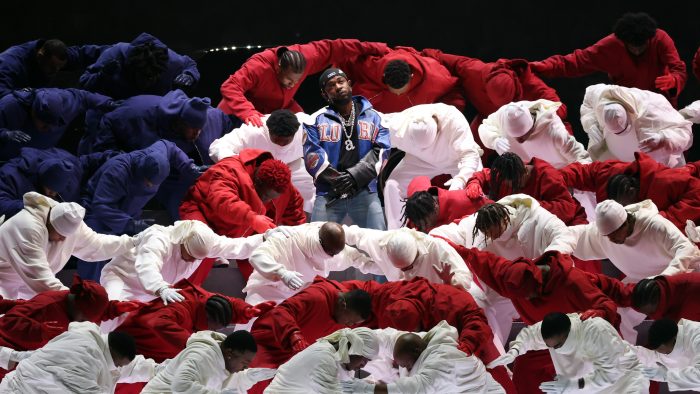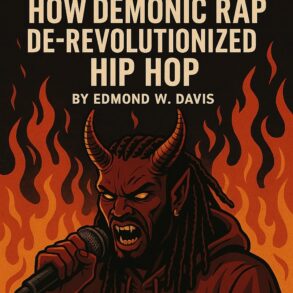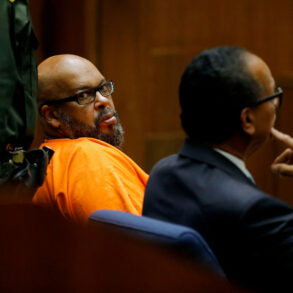Kendrick Lamar’s last 12 months have been so full of the phrase “all time” that it started to sound like the hyperbole you’d find in braggadocious rap lyrics. Winner of the greatest rap feud of all time. Most dominant rap beef victory of all time. Greatest rap diss record of all time (twice!). Best year any rapper has had of all time. And finally when he got booked to perform at the halftime show for Super Bowl LIX in New Orleans, Lamar became the star of the most anticipated and probably most-viewed solo rap performance of all time.
The pressure was palpable. Lamar was tasked with setting the standard for rap at the Super Bowl while also kicking down doors for more solo acts to follow in his wake. He was also under pressure to execute the global death knell to his most public adversary, Drake — but not too nasty of a way as to not deter from his historic performance. Add in the last-minute pressure to do something as a form of protest while Donald Trump was in attendance, and we have Lamar at the center of a moment that feels like it may last forever.
From Frenchmen Street to St. Charles, the rumblings about what Lamar’s performance would bring ranged from comparisons to Prince’s halftime show in 2007 to speculation that he would do something even more dastardly to Drake than he’s done so far. It seemed like an impossible bar to leapfrog. But over the course of 15 minutes, Kendrick Lamar gave us what we needed. He was defiant, proud, vindictive, playful and celebratory. He was pro-Black and subversive, trolling and joyful, and through all the expectations and fighting and nastiness, he was ultimately victorious. Lamar was aspirational, inviting us along with him.
In short, Lamar was all the things that make him him; and make us us.
America is always a main character in Lamar’s music. Whether it’s the state of the hood as a result of a uniquely Black existence in this country as outlined in his debut album good kid, m.A.A.d city; the White House in the background of his 2015 follow-up To Pimp A Butterfly album cover; or the rallying cry against the scourge of colonialism on his biggest song yet, “Not Like Us,” Lamar is always pushing up against what it means to be Black and American. Which is why the very first thing we saw in his halftime performance was actor Samuel L. Jackson dressed as Uncle Sam narrating the showcase as well as a voice in Lamar’s head, telling him to play it safe and humble himself for America.
When Lamar opened the show with his homies hopping out of his Buick GNX, a metaphor for his neighborhood and homies invading Americana, he’s admonished by Uncle Sam to humble himself. And when Lamar and his dancers formed a human American flag on the field during his smash hit “Humble,” it was clear there was going to be a larger statement about the country when it needs a mirror the most. The question then became how far Lamar would go.
During his performance, Lamar wanted to deliver a message and a series of messages aimed directly at Black folks who are yearning for a place to rest our hearts. It’s what he has done so brilliantly in the midst of his feud with Drake. Part of Lamar’s attack on his Canadian nemesis has been positioning Drake as an extension of an establishment whose goal is to tear down Black folks. Yes, Drake is a colonizer according to Lamar, but it’s not just about that. It’s about getting rid of all colonizers. So when Lamar dropped his most powerful easter egg of the performance — Serena Williams — it was a wink to a particularly Black audience.
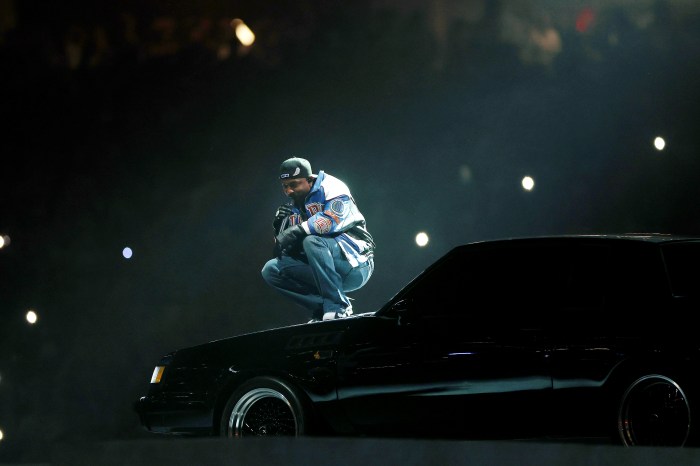
Gregory Shamus/Getty Images
Williams has been the target of Drake and America at multiple times in her career. She’s been unfairly targeted for daring to be great, or, in Drake’s case, disinterested in a relationship. During the performance of “Not Like Us,” Williams danced on the field — a middle finger to Drake and timely reminder that Lamar defended her, and the culture, on the song. But if you recall, back in the 2012 Olympics, Williams celebrated her Gold medal by c-walking on the court. The move, an homage to her Compton roots and something Black folks had been doing for ages, became another opening for attack as far too many people accused her of being “ghetto” and too cocky for daring to shout out her hometown and rejoice in victory.
Lamar gave Williams space to reclaim that dance as he was rapping about the ills of folks who don’t belong in the same universe as Black excellence trying to tell us what to do.
It’s that rebellion that fueled Lamar’s performance. A few weeks before the halftime show, Drake issued several legal actions that seemingly attempted to stop Lamar from performing “Not Like Us.” Again, this pitted Drake as something other than part of hip-hop culture because he was trying to silence a fellow artist and stop our collective joy. So when Lamar told us that he knows people don’t want him to perform the song during the show or they’ll sue, Uncle Sam warned the Compton MC not to fly too close to the sun with his pride. It was a conflation of Drake and America that is ironic given Drake’s Canadian heritage, but also a strategic move aided by Drake’s actions.
Lamar’s refusal to be silenced is another signal to us. Just take the gigantic, Joker-like, already-viral smile across Lamar’s face when he said Drake’s name while he performed “Not Like Us.” Look at the way he allowed the audience to say “pedophile” and sing along with tens of thousands of people in a packed Superdome who yelled out “a minor” — one of the more deafening moments of the entire game, let alone performance. Lamar was poking fun at anyone daring to stop his momentum, and encouraging us to do the same.
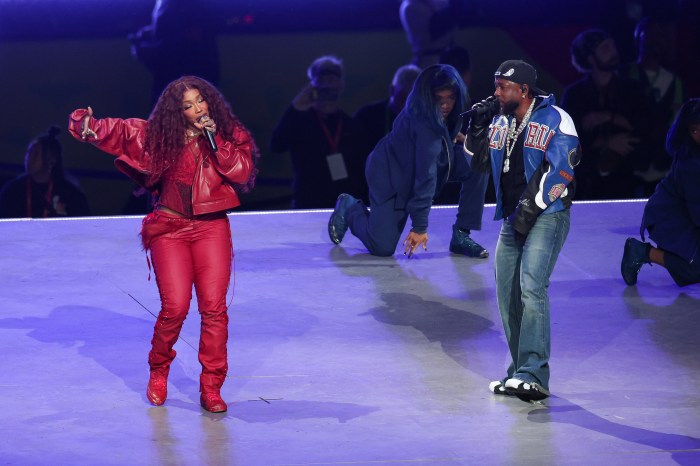
Christopher Polk/Penske Media via Getty Images
GNX, the album Lamar dropped as a surprise in November, was created for this moment. The songs are massive and were clearly made for a stadium. And they worked. “Squabble Up” and “Peekaboo” fit nicely next to established juggernauts like “DNA” and “All The Stars” (SZA sounded pitch perfect for the two songs she also performed, which can’t be ignored and can’t be lost on Roc Nation decision-makers looking for future talent for the show). But the most surprising song featured during the Super Bowl was “Man at the Garden,” whose refrain “I deserve it all” is another prideful and empowering chant for Black folks. Finally, the exuberance of “TV Off” felt appropriate to end Lamar’s set. And with “Game Over” spelled out in lights in the stands at the end of his performance, it seems Lamar is ready to move on from the most lopsided battle in rap history.
Lamar won and demanded that we find victories in our own battles.
After the no-pun-intended euphoria of the performance had worn off, I found myself wondering why Lamar left off “Alright” — the song that had become a protest anthem for the Black Lives Matter movement and whose lyrics “we hate po-po, wanna kill us dead in the streets for sho’” he previously censored when he performed during halftime a couple of years ago. Why not give us that moment, too? I hope it was a creative decision and nothing more.
But therein lies the uphill battle of protest music at the Super Bowl. Lamar performed between the end zones where the slogan “End Racism” used to be. A few days before the Super Bowl, the NFL made the decision to remove the slogan, coinciding with a nationwide rebuke of DEI, where Black folks’ accomplishments are questioned as much as ever before. To perform at a halftime show for an organization like the NFL implies a tacit complicity in that type of empire, even in the face of raised Black fists at the 20-yard line. And for a certain sector of the audience, nothing Lamar says or does will erase that complicity. He can’t be all things to all people and we aren’t supposed to ask celebrities to wear freedom on their sleeves at every turn. But Lamar invites that expectation and anticipation with his catalog, and when he opens up shows with one of the world’s biggest rappers dressed as the personification of America.
How our expectations bump up against his actual execution is a societal litmus test. But I can honestly say that I think Lamar is always trying. To see him is to see an artist at his peak trying to give us his best and empower us as much as he humanly can, even though he’s imperfect. In a new era of rap where our once-beloved luminaries are becoming increasingly toothless and disappointing, a guy who is trying to make his biggest moment about us is more than enough to earn respect and feel proud.
I first saw Kendrick Lamar live at a small bar on 6th street at South by Southwest in Austin, Texas, a decade and a half ago. A couple of hundred fans packed the room and almost caved in the floor when he performed cuts from his Overly Dedicated mixtape. There was something then. An earnestness. A desire to be the best and bring his homies and fans along for the ride.
Now, Lamar’s done all the things rappers say they’ll one day be able to accomplish in their most self-aggrandizing bars. He’s reached GOAT-level status. And he could have made the halftime show a victory lap for himself — he would have deserved it.
Instead, Kendrick Lamar poured into us. It’s that kind of beautiful work that doesn’t go forgotten. That’s how you take the most-scrutinized 15 minutes of live raps an MC has ever had to face and turn it into immortality.
This post was originally published on this site be sure to check out more of their content.



